
International Research Journal of Engineering and Technology (IRJET) e-ISSN:2395-0056
Volume: 11 Issue: 04 | Apr 2024 www.irjet.net p-ISSN:2395-0072


International Research Journal of Engineering and Technology (IRJET) e-ISSN:2395-0056
Volume: 11 Issue: 04 | Apr 2024 www.irjet.net p-ISSN:2395-0072
Sandip a. bhayani
Mechanical department,l.j. college,near sanand-sarkhej road,makarba,sarkhej-okaf,Gujarat 382210
Abstract - Fiber Reinforced Polymer (FRP) materials have become increasingly popular in various industries due to their unique properties. FRPs are composed of a polymer matrix reinforced with fibers, and their strength and stiffnesscan be tailored by selecting different fibertypes and orientations. The FRP (Fiber Reinforced Polymer) is an alternative to materials like wood, plastic, metals, etc. The life expectancy of FRP is around 20 to 30 years. It has very good properties, and its strength is equivalent to steel in the longitudinal direction in civil industries and other production industries very rapidly because it is very lightweight and uses in rapid civilizations. However, the challenges exist in the manufacturing and design of FRP structures, including the need for specialized equipment and expertise. This paper provides an overview of FRP materials and their applications, highlighting their advantages and limitations. It is majorly made by the pultrusion process (specially thermosetting polymer) with various reinforced fibers and various resin matrix with different stacking of fiber and different proportions of resin matrix. It has very good properties against the salty water and other harsh environmentalindustrial applications.
Key Words: Fiber Reinforced Polymer (FRP),Polymer Matrix, Pultrusion Process, Strength and Stiffness Tailoring, Longevity and Durability
composite material a materials are made by human being are most sufficient and most accurate work presence in modern era. composite materials are made by creating proper mixture of two or more materials having significant different properties, when it combines and making a new material with good properties of mixed materials. ex, the first composite material made by hum am is mud bricks, it's a combination of mud and bamboo strips, both have special properties, bamboo gives strengthandmudgivescohesivenesstobricks.composites materialsmainlymakesforeliminatethebadpropertiesof materials in particular use, like weight, stiffness, density, thermal conductivity, heat dissipation, elongation, corrosion, chemical effect, environmental effect on materialandenvironmentetc.
the most of problems are covered in frp materials ,frp stands for fiber re-inforced polymers/fibre re-inforced
plastic.by using the finite element method of square and round and various cross section shape for predicting and theexperimentingthebehaviouroffrpmaterialinvarious field it has very good proerties in longitudinal direction but it very low or moderate in transverse(lateral) direction.
The basic components for making frp material is plastic resin or polymer matrix and different types of fibre, according to requirement the types of components are changed, below figure shows the how reinforced fibre(syntheticfibers)aremadefromdifferentthings.

Chart-1: differenttypesoffibreparticles
2.1.1.HYBRID FIBERS :
Hybrid fibers in composite materials refer to the combination of two or more different types of fibers, typically natural and synthetic fibers, to create a composite with enhanced properties. By blending fibers with distinct characteristics, hybrid composites can achievea synergistic effect, incorporatingthestrengths of each fiber type. This results in improved mechanical properties, such as increased strength, stiffness, and impact resistance, compared to using a single fiber type. Hybrid fiber-reinforced composites are gaining attention in various industries due to their ability to tailor properties to specific application requirements, offering a versatile and efficient solution for advanced material designandengineering.

International Research Journal of Engineering and Technology (IRJET) e-ISSN:2395-0056
Volume: 11 Issue: 04 | Apr 2024 www.irjet.net p-ISSN:2395-0072
Natural fibers are derived from plants, animals, or minerals and offer eco-friendly and sustainable alternatives to synthetic fibers. Common natural fibers includejute,hemp,flax,cotton,andsisal,eachwithunique properties such as biodegradability, low cost, and high specific strength. Natural fiber composites exhibit good mechanical properties, lightweight characteristics, and reduced environmental impact compared to synthetic counterparts. These fibers are widely used in various industries like automotive, construction, and packaging due to their renewability and biodegradability. Ongoing research focuses on optimizing natural fiber composites for improved performance, making them increasingly popular in the quest for environmentally conscious materials.
basicallymatrixiselementtostrengthenthefrpfibre,itis macro and micro component that is differed in chemical compositionaccordingtoneedandmixedwithresinsand a plied in frp resin.it gives a superior strength to frp material.
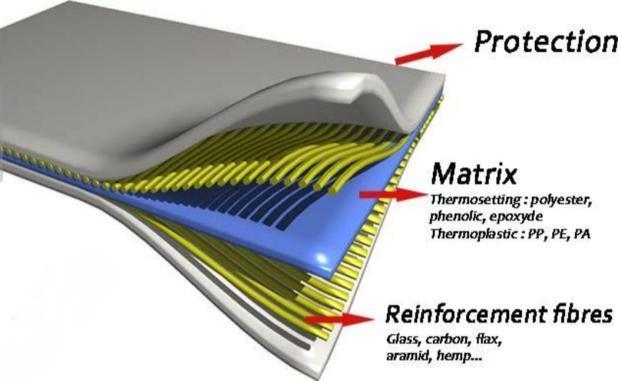
Fig-1: structureofmatrixinfrpmaterials
According to various composition matrix decided in four various types,

Chart-2 : chartrepresentingdifferenttypesofmatrix'sin frpmaterials
1.PMCs(polymermatrixcomposites)
2.MMCs(metalmatrixcomposites)
3.CMCs(ceramicmatrixcomposites)
4.C/Cs(carbon/carbonmatrixcomposites)
2.2.1. PMCs (polymer matrix composites)
Thepmcsconsistsapolymer(resin)matrixcombinedwith variousfibre
properties:
popularduetolightweight highstiffness
highstrength
Ex.thermosets:epoxyresin,phenolformaldehyderesin.
thermoplastics: polystyrene, polyethylene, poly amide, nylon,polypropylene.
2.2.2. MMCs (metal matrix composites)
Itbasicallyconsista light weight material likealuminium, magnesium, titanium and copper etc., and it re in-forced with particular type ceramic like ceramic, graphite and silicon.
properties:
lowdensity
highstrengthandstiffness
highthermalstabilityandconductivity
2.2.3. CMCs (ceramic matrix composites)
Itonlyconsistceramicfibrewithceramicmatrixmaterial. example:clay,siliconcarbide,alumina,porcelain
properties:
highmeltingpointandtoughnessandstrength corrosionresiststableathightemperature.
2.2.4. C/Cs (carbon/carbon matrix composites)
Itinsistagraphitematrixwithcarbonfibre.
properties:
specially mixed with each other to achieve a hard metrial andhighthermalresistance.

Volume: 11 Issue: 04 | Apr 2024 www.irjet.net p-ISSN:2395-0072
itisverylessbrittleinnaturecomparedtootherceramics.
Themainpropertiesoffrpmaterialsareshowedbelow,
1.tensilestrength
2.flexuralstrengthandmodulus
3.compressivestrength
4.shearstrength
5.impactresistance
6.fatigueperfomance
7.environmentaldurability
8.fireperfomance
9.thermalandelectricalstability
10.seacorrosion
11.recylability
3.1. tensile strength
accordingtoresearchpapersandexperimentswecansay that from (table 1) the strength of frp material are very good(specially CFR and GFRP),the reason for good strength is that the fibre are embedded in with matrix polymer wich gives good strength to fibre,and also from various major factors like fiber type, fiber orientation,matrix material proportion of natural fibres etc.

Table-1: tablerepresentsthedifferenttypesof mechanicalpropertieswithsomematerials at exel composites UK, the researches show the experiment on natural fibre made by thermosetting resin, hemp and wool in proportion of 65-30-5 by weight, with diameter of 4.8 mm with curing temperature of 120-190 degreecelcius.byusingofpolyurethaneresinmetrixwith naturalfibreshows3to4timesmoreflexiblecomparedto other polymer resin metrix,the GFRP has much higher tensile strength and modulus compared to wool/hemp fibre.
From experiment its a tendency to bend, and from the graphweobservedthepolyesterhasgreaterstrengththan othertwocomposites.

Chart-3 :graphrepresentsthedifferentflexuralstrength ofdifferentmaterialsonhemporwoolfibre matrix structure
From observing the graphs we can say that the flexural strengthinpolyesterishighcompared,
To other two, compared polyurethane and vinyl ester has tosamestrength.
In flexural modulas vinyl ester has highest modulus comparedtwopolyesterandpolyurethane.
from the experiment and observing the graph we can say that the vinyl ester are slightly less in tensile and compression both due to lower strength of matrix of poorerbondingbetweenusedfibreandmatrix
By observing the graphs we can say that the compressive strength and matrix all material is approx equal to each other. International Research Journal of Engineering and Technology (IRJET) e-ISSN:2395-0056

Chart-4 :graphrepresentsthedifferentcompression strengthofdifferentmaterialsonhemporwoolfibre matrixstructure

International Research Journal of Engineering and Technology (IRJET) e-ISSN:2395-0056
Volume: 11 Issue: 04 | Apr 2024 www.irjet.net p-ISSN:2395-0072
3.4. shear strength
by analysis if various maded model for experiencing and predicting the behaviour of shear strength and flexural stresses on rc beam using frpmaterial withconsideration ofstressconcentration,fatiguefactor.TheCFRPandGFRP give very good strength by wrapping frp in shape of ushapeandjacket.
3.5. impact resistance
FRP materials often exhibit good impact resistance, but this property can vary depending on factors such as fiber type, matrix toughness, and laminate layup. Research investigates the impact behavior of FRP composites through impact testing methods like Charpy or Izod tests, assessing energy absorption, damage resistance, and failuremodes.
3.6. fatigue perfomance
Understanding the fatigue behavior of FRP materials is critical for assessing their long-term durability under cyclic loading conditions. Research papers may focus on fatigue testing of FRP composites, studying factors like fatiguelife,stressconcentrationeffects,andfatiguefailure mechanisms.
3.7. environmental durability
the frp material had excellent environmental durability, making them suitable for various applications in challenging environmental conditions like, Corrosion Resistance, UV resistance, chemical resistance, weather etc.
3.8. fire perfomance
according to fibership research project, This project aims to enable construction of over 50-meter-long ships using FRP materials. The study's first phase tested seven resin systems using cone calorimeter tests, revealing that phenolicresinhadthebestfireperformance.Intumescent coatingsimprovedFRP fire performance, but other issues like mechanical properties and manufacturing processes also influenced product selection. The study ultimately aimstoenhanceFRPuseinshipbuildingandtheEuropean shipbuildingindustry'scompetitiveness.
3.9.
Fiber-ReinforcedPolymer(FRP)materialshaveverygood thermalstabilitybymakingthemsuitableforapplications ofvariousrelatedtemperatures.
in Thermal Insulation the frp material sandwich offer thermal insulation benefits, making them a preferred choice for structural engineering applications where
temperature control is required. with uses of CFRP and cementtypematrixwithGFRP.
according to research in china, the feasibility of using Fiber Reinforced Polymer (FRP) composites rebar as a replacement for traditional steel bars in marine sand concrete due to its good corrosion resistance. It explores the potential of FRP to improve building durability in alkaline environments like seawater sea sand concrete. The study compares Glass Fiber Reinforced Polymer (GFRP)andCarbonFiberReinforcedPolymer(CFRP)steel bars, frp has life expectancy around 20 to 30 years, in highlighting differences in corrosion resistance and performance in SWSSC(sea water and sea sand concrete). It addresses failure characteristics of FRP composites rebar after corrosion, emphasizing the importance of the resin matrix in maintaining bonding with concrete. Strategies such as finding more corrosion-resistant resin matrices oraddinglayersat the fiber-matrix interfaceare proposed to enhance the performance of FRP composites rebars.
The recyclability of frp materials is an important aspect for sustainable waste management and environmental conservation. Here the recyclability of frp materials can recycled by mechanically, thermally, chemically, composite-to-composite(convert frp waste in another form of frp used again) and circular economy initiatives(usingfrpinloop).
4.METHODS OF MAKING OF FRP COMPOSITE
thefrpmaterialsaremadebyeightmethods,
1.handlay-up
2.spraymoulding
3.wetcompressionmoulding
4.resintransfermoulding
5.filamentwinding
6.injectionmouldingprocess
7.electrospinningprocess
8.pultrusionprocess
4.1. hand lay-up
the hand lay-up method is very easy and traditional method for making frp material part,this process is very cheap and it doesn't required any highly skilled

International Research Journal of Engineering and Technology (IRJET) e-ISSN:2395-0056
Volume: 11 Issue: 04 | Apr 2024 www.irjet.net p-ISSN:2395-0072
worker.theeasypartsaremadeeasily.
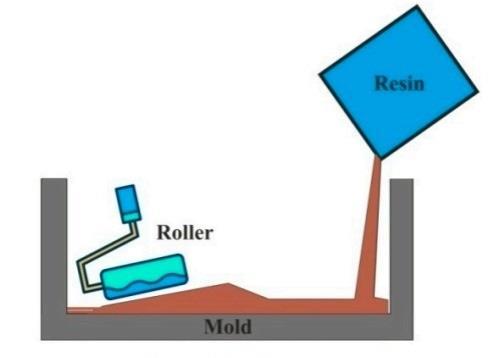
Fig-2: figureofhandlay-upprocess
ex.Wind-turbine blades, boats, architectural shapes, secondarystructureinaerospace,Composites,automobile parts,Dashboardanddeck.
4.2. spray moulding
in spray moulding process the fibre are thrown by spray gun in form of small fibre and simultaneously mixed with resin.this mixture sprayed on part die and leave for drying,itismorespeedythanhandlayupmethod,ittakes timefordryingofmixture.
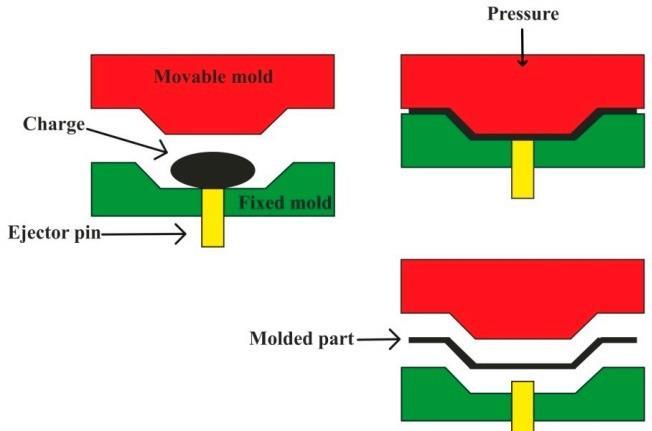
Fig-4: figureofwetcompressionmouldingprocess
Ex.prototypes, small-scale parts, and components with complex geometries in industries such as automotive, aerospace,andconstruction.
4.4. resin transfer moulding
this process is very similar to injection moulding process,in this process the die is split in two part and closed tighthly one resin injection unit is inserted in die and die filled with resin and fibre mixture, for easily removal of mould the ejector pin and vent are given in die.itisveryproductiveinmassproduction.
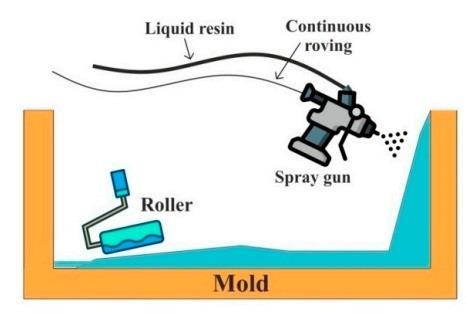
Fig-3: figureofspraymouldingprocess
ex.caravan bodies,truck fairings,bathtubs,shower trays,smalldinghies,Venthoods,boats,showerunit.
4.3. wet compression moulding
inthismethodthefibreiscoatedbyresinonbothsideby hopper and catted by required dimension and arranged mutltidirectionally then put in die and pressed with heating,after some time mould is taken out from die.this method is very useful in large and precise part manufacturing.
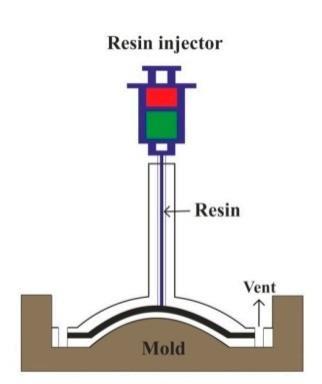
Fig-5: figureofresintransfermouldingprocess
ex.bath and Shower enclosures,cabinets,aircraft parts,automotive.
4.5. filament winding
this process is very similar to pultrusion process,in this process the resin rovings are continuous pulled by roller anddippedinresin baththenthroughniprollersinturns in circular shape in guide and turned on die outside,the guideismovingandwindthefilamentoverthedie.

International Research Journal of Engineering and Technology (IRJET) e-ISSN:2395-0056
Volume: 11 Issue: 04 | Apr 2024 www.irjet.net p-ISSN:2395-0072
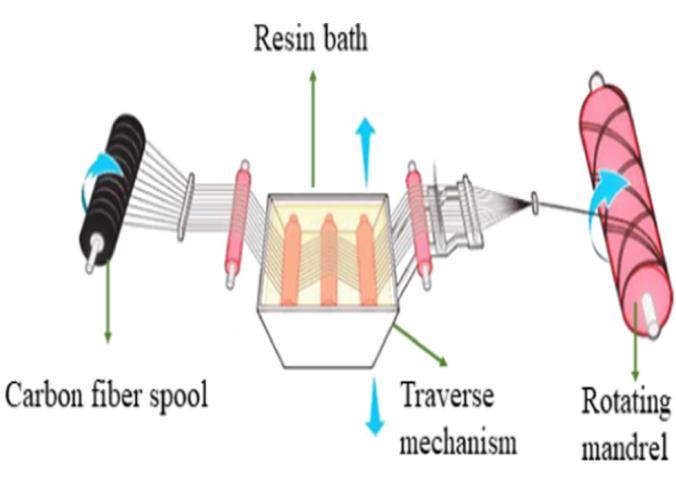
Fig-6: figureoffilamentwindingprocess
ex.Pipe lines,tubing, pressure,vessels,tanks,gas cylinders,fire-fighters,breathing tanks,tube light poles, aircraft fuselages, wing sections,randomness,helicopter rotorshafts.
4.6.injection moulding process
It is very useful and very fast process for making frp material components,it is basically based on die shape.in thisprocess,thereadymadefibreandresinmixturepallets are stored in hopper and when it heated and melted,it goes through nozzle with help of rotating screw or pressureram.
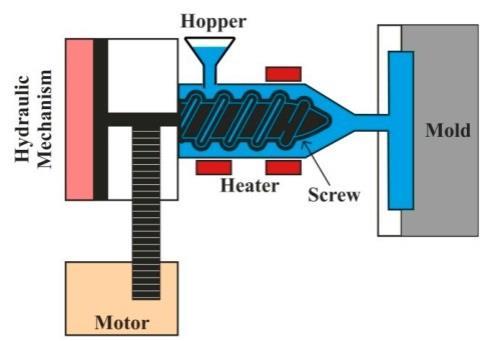
Fig-7: figureofinjectionmouldingprocess
Ex. Die based parts,medical,automobile,mechanical parts etc.
4.7Electrospinning process
In this process the continuous fibre are thrown in nozzle of diameter nanometer or micrometer and it thrown by spinneretbyelectricforcesanditiscollectedoncollector.

Fig-8: figureofelectrospinningprocess
Ex.biomedical applications (wound healing,tissue engineering scaffolds,drug delivery), bio sensors,enzyme immobilization,cosmetics,etc.
4.8. pultrusion process
inthisareathisprocessiswidelyusedinmassproduction of continuous production, in this process the fibre are continuous are coming out from rovings and goes into impregnation bath after goes into pre-former, here the resinareclosetogetherandtakingshapeaccordingtodie, after the fibre and resin mixture goes into temperature control die and and takes final shape of die, during this wholeprocesstheresinarepulledbytwocaterpillarhaul off system that's for that reason this process is called pultrusion process after the ready shape are cutted requireddimension.
This process is very effective,this can produce rebars of various cross sections.

Fig-9: figureofpultrusionprocess
ex.Bar and rod,pipe,tubing,ladder rails and rungs and supports of many kinds,Beams and girders used in roof structures,bridges,frameworks.
5.FUTURE AND INCOMING DEMAND OF FRP
the future of frp materials are used in modular construction with efficient structural design and rapid assembly due to easy uses of frp material to create

International Research Journal of Engineering and Technology (IRJET) e-ISSN:2395-0056
Volume: 11 Issue: 04 | Apr 2024 www.irjet.net p-ISSN:2395-0072
innovative design of buildings,it's life expectancy around 50 to 60 years approx.the ability of FRP composites to offer a combination of strength, durability, corrosion resistance,anddesignflexibilitymakesthemacompelling choice for replacing conventional materials in various industries and applications. As research and new technologyiscontinuetoadvanceinthefieldofcomposite materials, the use of FRP composites is can be a sustainable and innovative solution for modern engineeringchallenges.
In conclusion, Fiber Reinforced Polymer (FRP) materials offer a promising solution for modern engineering challenges.Withacombinationofstrength,durability,and design flexibility, FRP composites are increasingly replacing conventional materials in various industries. Their properties, including excellent environmental durability and fire performance, make them ideal for applications in challenging conditions. As research and technology advance, FRPs role in modular construction andinnovativestructuraldesignisexpectedtogrow,with a lifespan of around 50 to 60 years. Acknowledging the collective efforts of researchers and industry peers, FRP continues to evolve as a sustainable and innovative materialchoice.
The paper on FRP materials acknowledges the contributions of various researchers, including Li, Shen, Dong, and Peng etc., whose studies provided insights into FRP properties. These references enriched understanding of FRP mechanical properties, manufacturing, and applications. The paper also appreciates the guidance from mentors and peers, underscoring collective efforts that shaped its content.This acknowledgment recognizes the broader academic and industrial community for advancing knowledge on FRP materials and their applications, emphasizing collaboration and shared expertise.
1) Li, Jiapeng. “Application of Corrosion Resistance of FRP Composites Rebar in Sea Water Sea Sand Concrete.” Applied and Computational Engineering, vol. 7, no. 1, EWA Publishing, July 2023, pp. 131–35. Crossref, https://doi.org/10.54254/27552721/7/20230401.
2) Shen, Kongjian, et al. “Theoretical Analysis on Full Torsional Behavior of RC Beams Strengthened With FRP Materials.” Composite Structures, vol. 183, Elsevier BV, Jan. 2018, pp. 347–57. Crossref, https://doi.org/10.1016/j.compstruct.2017.03.084.
3) Dong,JiangFeng,etal.“ShearBehaviourofRCBeams Strengthened With FRP Materials.” Advanced Materials Research, vol. 463–464, Trans Tech Publications, Ltd., Feb. 2012, pp. 249–53. Crossref, https://doi.org/10.4028/www.scientific.net/amr.46 3-464.249.
4) Peng, Xi, et al. “Properties of Natural Fiber Composites Made by Pultrusion Process.” Journal of Composite Materials,vol.46,no.2,SAGEPublications, Aug. 2011, pp. 237–46. Crossref, https://doi.org/10.1177/0021998311410474.
5) Lam,L.,andJ.G.Teng.“Design-OrientedStress-Strain Model for FRP-Confined Concrete in Rectangular Columns.” Journal of Reinforced Plastics and Composites, vol. 22, no. 13, SAGE Publications, Sept. 2003, pp. 1149–86. Crossref, https://doi.org/10.1177/0731684403035429.
6) Cousin, P., et al. “Chemical Resistance of Carbon, Basalt, and Glass Fibers Used in FRP Reinforcing Bars.” Journal of Composite Materials, vol. 53, no. 26–27, SAGE Publications, Apr. 2019, pp. 3651–70. Crossref, https://doi.org/10.1177/0021998319844306.
7) Ceroni, Francesca, et al. “Durability Issues of FRP RebarsinReinforcedConcreteMembers.” Cementand ConcreteComposites,vol.28,no.10,ElsevierBV,Nov. 2006, pp. 857–68. Crossref, https://doi.org/10.1016/j.cemconcomp.2006.07.004.
8) Duo, Yongyu, et al. “Environmental Impact on the Durability of FRP Reinforcing Bars.” Journal of Building Engineering, vol. 43, Elsevier BV, Nov. 2021, p. 102909. Crossref, https://doi.org/10.1016/j.jobe.2021.102909.
9) Günaslan,SultanErdemli,AbdulhalimKaraşin,andM. Emin Öncü. "Properties of FRP materials for strengthening." International Journal of Innovative Science, Engineering & Technology 1.9 (2014): 656660.
10) Hakkarainen, Tuula, and Antti Paajanen. "Fire performance assessment of FRP materials." Book of Proceedings-Nordic Fire and Safety Days 2018 (2018).
11) Rousakis, T. C., G. Manolitsi, and A. I. Karabinis. "FRP strengthening of RC columns: Parametric finite elementanalysesofbarqualityeffect."Proceedingsof the 1st Asia-Pacific Conference on FRP in Structures (APFIS2007),Hong-Kong,China.2007.

International Research Journal of Engineering and Technology (IRJET) e-ISSN:2395-0056
Volume: 11 Issue: 04 | Apr 2024 www.irjet.net p-ISSN:2395-0072
12) Kumar, Anil, et al. "Mechanical properties evaluation of eucalyptus fiber reinforced epoxy composites." J. Mater.Environ.Sci6.5(2015):1400-1410.
13) Moschiar, S. M., M. M. Reboredo, and A. Vazquez. "Pultrusion processing." Advanced polymer processing operations. William Andrew Publishing, 1998.126-156.